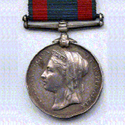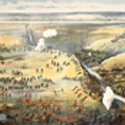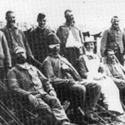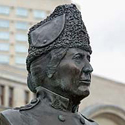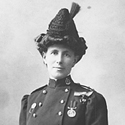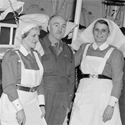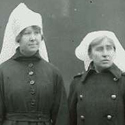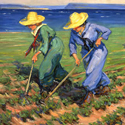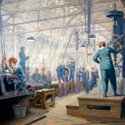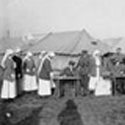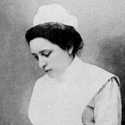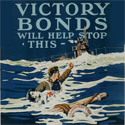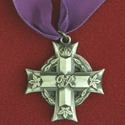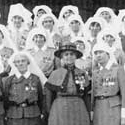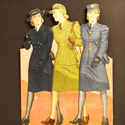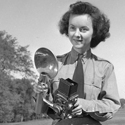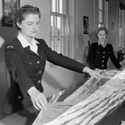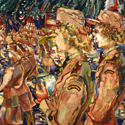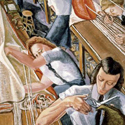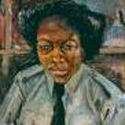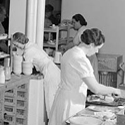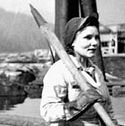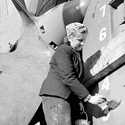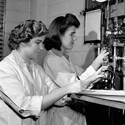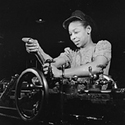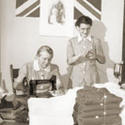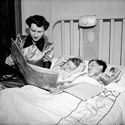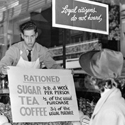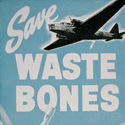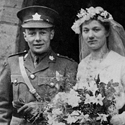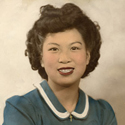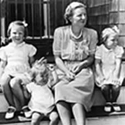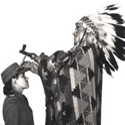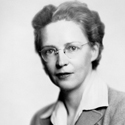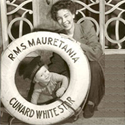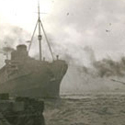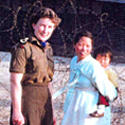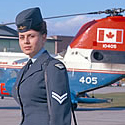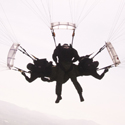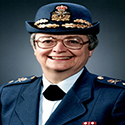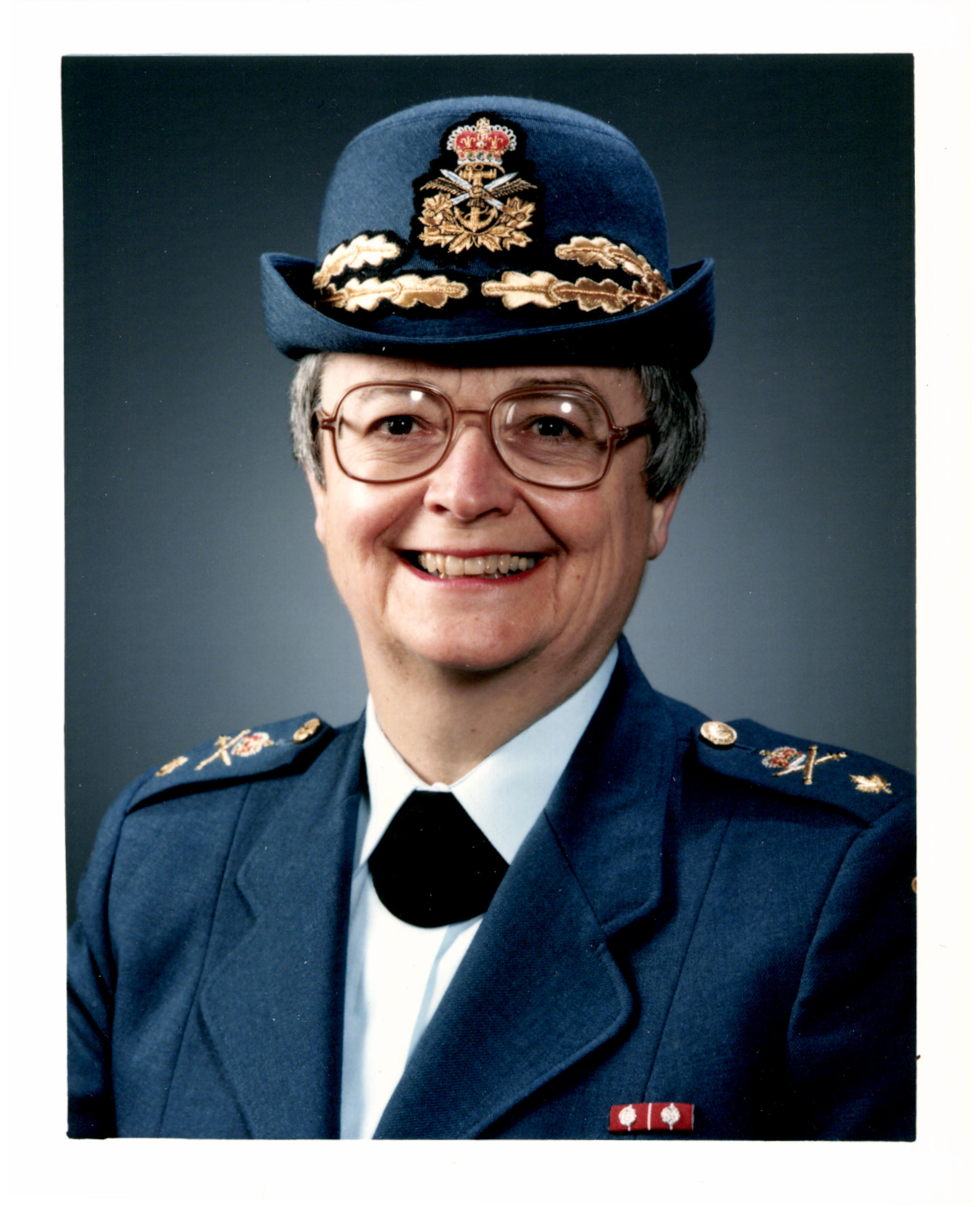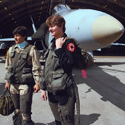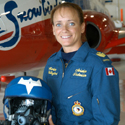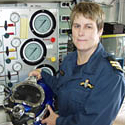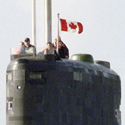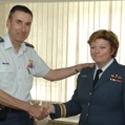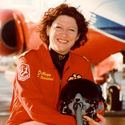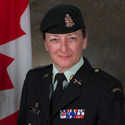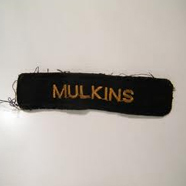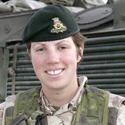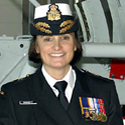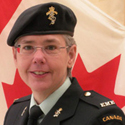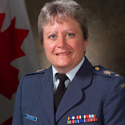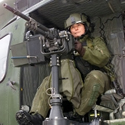Timeline
Women have been a part of Canada's military for over 100 years. Here's a look at their history.
Events
Table of Contents
1885 North-West Rebellion
Women served for the first time in Canadian military history as nurses in the field to provide care to the Canadian troops in Moose Jaw and Saskatoon, Saskatchewan. They made bandages, took care of the wounded and prepared medicinal and food supplies. Their tour of duty lasted four weeks. A total of 12 nursing sisters were awarded the Campaign medal for service in the North-West in 1885.
1899 - 1902: The South African War (or Boer War)
Four nursing sisters sailed with the first contingent of soldiers to South Africa in October 1899.
The Canadian Army Nursing Service was created in 1901, and more nurses were dispatched.
A total of 12 Canadian Nursing Sisters served.
Nurses had to deal with a hot climate, lack of sanitary facilities and lack of adequate antiseptics which led to outbreaks of disease and infection.
1908
Georgina Fane Pope became the first matron-in-chief of the Canadian Army Nursing Corps when the corps began it's official existence. Pope managed military hospitals and the recruitment of nurses.
First World War 1914 - 1918
Nursing Sisters in the First World War
Nursing became increasingly organized and recognized. More than 2,800 women served with the Canadian Army Medical Corps. and roughly 2,500 went overseas where they served close to the front lines in hospitals, on board hospital ships, and in combat zones with field ambulance units.
Nurses who served in the First World War were called Nursing Sisters, but because of their blue dresses and white veils, they were nicknamed the "bluebirds".
Life for Canada's Nursing Sisters was dangerous. Over 40 lost their lives while in service, and of this number between 20 and 30 were killed by enemy action in the First World War.
Women On the Home Front in the First World War
Women's roles changed on the home front in the First World War:
Women provided crucial support at home as the wives, mothers and sweethearts of the men who had gone to fight.
Thousands of women on the home front also supported the war effort by volunteering their time to make and package things like pillows, sheets, socks and scarves to send to soldiers overseas.
The First World War also changed the role of women in the labour market. Over 30,000 women worked outside of the home in munitions factories, offices and in the countryside on their family farms due to the shortage of male workers.
1917
December 17, 1917, Canadian women whose husbands, sons and brothers served in the war voted for the first time. Women were also allowed to vote if they met an exception for military personnel. Bluebirds were the first women to vote legally in a Canadian federal election. The federal right to vote was extended to all Canadian women by 1918.
Aboriginal Canadian Edith Anderson, left her job as an elementary school nurse to join (along with 14 other Canadian Nurses), the United States Medical Corps in 1917. Overseas, she tended sick and wounded soldiers in an American military hospital in France.
1918
Post-First World War
1919
1924
Second World War (1939 - 1945)
Canadian women were not allowed to serve in combat during the Second World War, but they were still greatly involved in the war effort.
Nursing Sisters in the Second World War
In the Second World War, a total of 4,480 Nursing Sisters served.
1941 - 1942: Creation of Women's Divisions
All three branches of the military were forever changed with the creation of Women's Divisions. Some 50,000 women served with the Canadian Armed Forces:
On July 2, 1941, the Royal Canadian Air Force established a Women's Division (WD) and some 17,000 Women served in the RCAF(WD);
On 13 August, 1941, the Canadian Army created the Canadian Women's Army Corps, and some 21,000 women served as CWAC's;
On July 21, 1942, The Royal Canadian Navy created the WRENS (Women's Royal Canadian Naval Service), and some 7,000 women served.
Women volunteered in these Women's Divisions for full time military service, including working as clerks, mechanics, parachute riggers, wireless operators and photographers.
Others such as Molly Lamb Bobak, Paraskeva Clark and Pegi Nicol MacLeod worked as war artists, depicting the daily life of Canadian women soldiers.
Women on the Home Front in the Second World War
The war changed lives for women on the home front:
The demands of a war economy and the labour shortage that resulted from men serving in the war meant that women were encouraged to 'do their part' and enter the work force. Hundreds of thousands stepped into jobs in wartime industry in jobs typically held by men:
The Second World War led to an unprecedented mobilization of women into voluntary labour. Often they got together to make use of their domestic skills to support the war effort, doing things like knitting socks and gloves for the Canadians fighting overseas.
At home, women and mothers kept their families together and protected their way of life.
On the home front, women were also asked to reduce their consumption of goods that were in short supply, and to recycle in order to support the men and women serving overseas. Goals were set to collect tons of used rubber products (which could be recycled into vitally needed tires and other products important in the war effort). Gasoline was also rationed, with strict limits being set on how much could be used for different needs, such as personal use or agricultural requirements. Ration books were distributed to keep track of what people were allowed to have.
1940
1942
The first Nursing Sister of the Second World War to die as a result of enemy action was Nursing Sister Agnes W. Wilkie. She was one of 137 passengers and crew members who were lost in October 1942, when the Newfoundland ferryCaribou was torpedoed and sunk in the Cabot Strait.
Elsie MacGill was the first female aircraft designer in the world. In 1942, she took on the important job of supervising the Canadian production of Hawker Hurricane fighter planes and earned the nickname 'Queen of the Hurricanes.'
1943
Jean Flatt Davey became the first Canadian woman doctor to enter the Canadian Armed Forces. From 1941-1945, she served in the Royal Canadian Air Force as squadron leader, forming a unit that provided medical care.
In 1943, the initial pay rate for servicewomen was set at 2/3 of that for men, but in July 1943, it was raised to 80% of the pay of men at the time.
January 19, 1943, Dutch Princess Juliana gave birth to a baby girl. Before the baby was born, the Canadian Government perpared a document declaring the place of birth at the Ottawa Civic Hospital, as "extraterritorial" - meaning outside of Canadian territory, which meant that the baby was born a Dutch citizen.
1944
July 1944, Canadian Wives Bureau is set up by the Department of National Defence for the purpose of preparing war brides for their journey to Canada.
Post-Second World War
1946
Women's Divisions of all three services were disbanded, and women were expected to relinquish their roles to the men who were returning from war.
February 1946: "Operation Daddy" begins, with the sailing of Mauretania from Liverpool to Halifax carrying 943 servicemen's dependents (war brides and children), marking the first official war bride transport to Canada.
The Korean War (1950-1953)
Women are again recruited for military service, and more than 5,000 are serving. Canadian nurses were faced with providing medical services in a combat zone where they faced the daunting challenge of fighting battle-inflicted injuries and infectious diseases. They also flew air evacuation with casualties back to Canada. When the ceasefire came into effect in 1953, the sisters worked with the newly-released prisoners of war, helping to restore their physical health. There were no female casualties.
1960s
1965
The government decided to allow women to be employed in the Canadian military with a fixed ceiling of 1,500 (representing 1.5% of the military at that time)
1970s
The Royal Commission on the Status of Women recommended changes to the military to create equal conditions for all, especially for women in the Canadian Armed Forces. This opened doors for a number of women.
1972
The Honourable Flora MacDonald becomes the first woman to graduate from the National Defence College.
1973
Colonel Joan Fitzgerald becomes the first military woman to graduate from the National Defence College.
1974
Major Wendy Clay, a doctor, qualified for pilot's wings six years before pilot classification is opened to all women.
1978
Corporal Gail Toupin becomes first female member of SkyHawks, the Army's parachute demonstration team.
1979
Military colleges open to women.
81 of 127 military trades open to women.
1980s
1981
Second Lieutenant Inge Plug becomes first female helicopter pilot.
Lieutenant Karen McCrimmon becomes first female air navigator.
1982
Signing of the Canadian Charter of Rights and Freedoms, which changed the future of women by prohibiting discrimination based on sex.
1987
Air Force opens all positions to women.
Colonel Sheila A. Hellstrom, a graduate of National Defence College, became the first woman serving as a Regular Force officer to be promoted to the rank of Brigadier-General.
1988
First female gunners in Regular Force graduate from qualification training.
Private Shannon Wills wins the Queens Medal for Champion Shot of the Reserve Forces.
1989
The Canadian Human Rights Commission ruled that all obstacles to women's access to any military job must be removed, with two exceptions: service aboard submarines and Catholic chaplains.
Private Heather Erxleben becomes the first female Regular Force infantry soldier.
Lorraine Francis Orthlieb becomes first woman to reach Commodore.
Majors Dee Brasseur and Jane Foster become the first two woman fighter pilots of a CF-18 Hornet.
1990s
1991
The Gulf War is the first conflict in which Canadian women take part in combat.
HMCS Nipigon becomes the first mixed gender warship to participate in NATO exercises.
First female officers in combat arms graduates from artillery training.
1992
Corporal Marlene Shillingford becomes first woman to join Snowbirds team; takes part in 1993-94 season as a technician; and Sergeant Shillingford became the first female Canadian Forces Snowbirds Crew Chief in 2006.
1993
Lieutenant Leanne Crowe becomes first woman to qualify as clearance diving officer; subsequently first woman to become Officer Commanding of the Experimental Diving Unit.
1994
Wendy Clay becomes first woman promoted to Major General.
1995
Chief Warrant Officer Linda Smith becomes first woman named Wing Chief Warrant Office.
1997
Colonel Marcia Quinn assumes command of 41 Canadian Brigade Group.
Colonel Patricia Samson appointed Canadian Forces Provost Marshall.
1998
Lieutenant Colonel Karen McCrimmon is appointed Commander of 429 Transport Squadron in Trenton, Ontario.
Chief Petty Officer 2nd Class Holly Kisbee becomes the first woman Combat Chief of a major warship.
2000s
2000
Women can serve in submarines for the first time.
Major Micky Colton becomes, first female Hercules pilot to complete 10,000 flying hours.
Lieutenant Ruth Ann Shamuhn becomes the first female combat diver.
2001
Captain Maryse Carmichael becomes the first female Snowbird pilot.
2002
Chief Warrant Officer Camille Tkacz becomes the first woman appointed Command Chief position (Assistant Deputy Minister).
2003
Major Anne Reiffenstein becomes the first female to command combat arms sub unit.
Major Jennie Carignan becomes first female Deputy Commanding Officer of a combat arms unit.
Leading Seaman Hayley John and Marketa Semik becomes first female non-commissioned clearance divers.
Master Seaman Colleen Beattie becomes the first woman qualified as a submariner.
First (and only) all female Canadian Armed Forces team completes the Nijmegan March in Holland carrying same weight as male teams.
Lieutenant Commander Marta Mulkins becomes the first woman to serve as a captain of a Canadian warship.
2004
Chief Petty Officer 1st Class Jan Davis becomes first woman Coxswain of major warship.
2006
Brigadier General Christine Whitecross becomes first female Joint Task Force Commander.
Captain Nichola Goddard, 1st Regiment Royal Canadian Horse Artillery, was killed in Afghanistan on May 17, 2006. Goddard was the first female Canadian Armed Forces member killed during combat duty.
2007
Lieutenant Colonel Tammy Harris becomes the first woman to command an air force wing in Canada – 9 Wing in Newfoundland and Labrador.
Commodore Jennifer Bennett becomes the first woman appointed Commander of the Naval Reserve; first female to command a Formation.
2009
Commander Josée Kurtz becomes the first woman to command a major warship, the HMCS Halifax.
2010
Lieutenant Colonel Susan Wigg, one of the initial women to enrol at Royal Military College in 1980, becomes its first female Director of Cadets.
Lieutenant Colonel Maryse Carmichael becomes the first female Commanding Officer of the Snowbirds in its 40 year history.
Major Eleanor Taylor, the first female to lead an infantry company in a combat zone, is deployed to Afghanistan.
2011
Brigadier General Chris Whitecross is one of two most senior ranked women in the Canadian Armed Forces. She was deployed to Afghanistan until end of June 2011.
Women make up 15% of the Canadian military, with over 7,900 female personnel serving in the regular force and more than 4,800 women serving in the primary reserve. Out of that number, 225 women are part of the regular combat force and 925 are enlisted in the primary reserve combat force.
2012
Captain Ashley Collette receives the Medal of Military Valour for her actions in Afghanistan. She is the first female Canadian soldier to receive this honour.
2013
Colonel Jennie Carignan is the first female Commandant of the Royal Military College Saint-Jean in Quebec.
2015
Brigadier-General Lise Bourgon is commander of a Joint Task Force overseas mission (Operation Impact in Iraq). She is the first woman to hold this position.
2017
The Government of Canada announces the Elsie Initiative for Women in Peace Operations during a UN conference in Vancouver. Its goal is to help increase the participation of women in UN peace operations.
2020
Lieutenant-Colonel Riel Erickson assumes command of No. 2 Canadian Forces Flying Training School in Moose Jaw, Saskatchewan.
2021
Rear Admiral Josee Kurtz becomes the first woman Commandant of the Royal Military College in Kingston, Ontario.
2022
Rear-Admiral (Retd) Rebecca Patterson is the first woman Veteran appointed to the Senate of Canada.
2023
12 women hold the rank of general or admiral within the Canadian Armed Forces.
- Date modified:
